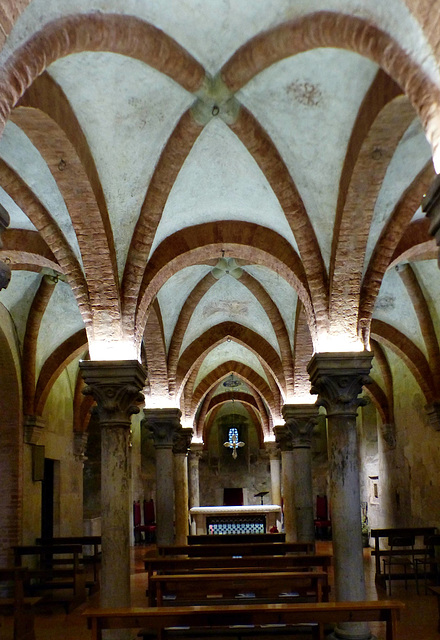Location
Lat, Lng: 44.866524, 10.057615
You can copy the above to your favourite mapping app.
Address: Cattedrale Di San Donnino
You can copy the above to your favourite mapping app.
Address: Cattedrale Di San Donnino
Keywords
Authorizations, license
-
Visible by: Everyone -
All rights reserved
-
271 visits
Fidenza - Cattedrale di San Donnino


In 1927, what is pretty recent, the city "Borgo San Donnino" changed it´s name to "Fidenza", as in Roman times it was known as "Fidentia Julia".
The city was named and the Duomo inside the walls was dedicated to San Donnino di Fidenza (aka "Domninus of Fidenza"), who was martyred nearby in 291.
Sigeric the Serious, Archbishop of Canterbury, made the pilgrimage to Rome following the Via Francigena around 990. His contemporary records of this journey still exist (and are source for the modern guide books). He reached "Sce Domnine" after 36 days, what is pretty fast for more than 1000kms.
The erection of the Cattedrale di San Donnino started in the 11th century, the first consecration took place in 1106, though the building process continued. From around 1200 on Master Benedetto Antelami and his workshop worked here, not only as Master masons. Antelami may as well be the architect of the facade.
Frederick Barbarossa had entrusted "Borgo San Donnino" to the Pallavicino family of Piacenza. In 1268 - after a siege - the city was conquered by the troops of Parma, who looted and burnt down it completely. All houses got destroyed at that time just the Duomo was saved, but it was not completed at that time. The building process came to a stop - and was never continued.
Some tiles around the altar, that since 1207 holds the relcics of San Donnino, date back to the paleochristian oratory built over the place of the Saint´s martyrdom. This oratory was enlarged during Lombard or Carolingian period to accomodate an ever increasing number of pilgrims. The current cathedral was then built over the church, that became the crypt.
The city was named and the Duomo inside the walls was dedicated to San Donnino di Fidenza (aka "Domninus of Fidenza"), who was martyred nearby in 291.
Sigeric the Serious, Archbishop of Canterbury, made the pilgrimage to Rome following the Via Francigena around 990. His contemporary records of this journey still exist (and are source for the modern guide books). He reached "Sce Domnine" after 36 days, what is pretty fast for more than 1000kms.
The erection of the Cattedrale di San Donnino started in the 11th century, the first consecration took place in 1106, though the building process continued. From around 1200 on Master Benedetto Antelami and his workshop worked here, not only as Master masons. Antelami may as well be the architect of the facade.
Frederick Barbarossa had entrusted "Borgo San Donnino" to the Pallavicino family of Piacenza. In 1268 - after a siege - the city was conquered by the troops of Parma, who looted and burnt down it completely. All houses got destroyed at that time just the Duomo was saved, but it was not completed at that time. The building process came to a stop - and was never continued.
Some tiles around the altar, that since 1207 holds the relcics of San Donnino, date back to the paleochristian oratory built over the place of the Saint´s martyrdom. This oratory was enlarged during Lombard or Carolingian period to accomodate an ever increasing number of pilgrims. The current cathedral was then built over the church, that became the crypt.
- Keyboard shortcuts:
Jump to top
RSS feed- Latest comments - Subscribe to the comment feeds of this photo
- ipernity © 2007-2025
- Help & Contact
|
Club news
|
About ipernity
|
History |
ipernity Club & Prices |
Guide of good conduct
Donate | Group guidelines | Privacy policy | Terms of use | Statutes | In memoria -
Facebook
Twitter











Sign-in to write a comment.